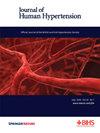多系统生物学方法揭示了hsa-miR-21在高血压患者神经系统疾病风险增加中的作用。
IF 3.4
4区 医学
Q2 PERIPHERAL VASCULAR DISEASE
引用次数: 0
摘要
高血压是一种普遍的疾病,它大大增加了患痴呆、中风和帕金森病等神经系统疾病的风险。MicroRNAs (miRNAs)在与脑功能和疾病相关的基因表达调控中发挥着关键作用。了解mirna在这些疾病中的作用可以为潜在的治疗靶点提供新的见解。本研究的主要目的是针对和研究与高血压患者神经系统疾病相关的microRNAs (miRNAs)。从GeneCard、MalaCard、DisGeNet、OMIM和GEO2R等数据库中鉴定高血压相关基因。利用系统生物学方法确定了高血压的关键基因。同时,通过计算机辅助药物设计方法确定了植物化学对高血压的有效作用。使用miRNet分析平台通过超几何测试确定关键靶基因的功能mirna。进一步,确定了基因与mirna的相互作用并进行了富集分析。RPS27A被确定为高血压的关键靶基因。柚皮素与RPS27A表现出有效的分子相互作用,结合能得分为-6.28。此外,从miRNet中确定了针对脑部疾病的mirna列表。利用PSRR工具构建了帕金森病、自闭症谱系障碍、急性脑梗死、垂体acth分泌腺瘤和室管膜瘤的基因- mirna网络。此外,miRNA 21和miRNA 16被发现与四种神经系统疾病有关。该研究确定了可能作为高血压患者脑部疾病潜在生物标志物的特定mirna。靶向这些mirna可以为减轻这类患者的神经损伤的治疗策略开辟新的途径。本文章由计算机程序翻译,如有差异,请以英文原文为准。

Multiple system biology approaches reveals the role of the hsa-miR-21 in increasing risk of neurological disorders in patients suffering from hypertension
Hypertension is a prevalent disease that substantially elevates the risk of neurological disorders such as dementia, stroke and Parkinson’s disease. MicroRNAs (miRNAs) play a critical role in the regulation of gene expression related to brain function and disorders. Understanding the involvement of miRNAs in these conditions could provide new insights into potential therapeutic targets. The main objective of this study is to target and investigate microRNAs (miRNAs) associated with neurological disorders in patients suffering from hypertension. The genes involved in hypertension were identified from various databases including GeneCard, MalaCard, DisGeNet, OMIM & GEO2R. The key gene for hypertension was identified using a systems biology approach. Also, potent phytochemical for hypertension was determined by computer-aided drug-designing approach. Functional miRNAs were determined for the key target gene using miRNet analytics platform by hypergeometric tests. Further, the gene-miRNA interaction was determined and enrichment analysis was done. RPS27A was identified as a key target gene for hypertension. Naringenin showed effective molecular interaction with RPS27A with a binding energy score (−6.28). Further, a list of miRNAs which were targeting brain disorders was determined from miRNet. A gene-miRNA network was constructed using the PSRR tool for Parkinson’s Disease, Autism Spectrum Disorder, Acute Cerebral Infarction, ACTH-Secreting Pituitary Adenoma, & Ependymoma. Further, miRNA 21 & miRNA 16 were found to be associated with four of the neurological disorders. The study identifies specific miRNAs that may serve as potential biomarkers for brain disorders in hypertensive patients. Targeting these miRNAs could open new avenues for therapeutic strategies aimed at mitigating neurological damage in this patient population.
求助全文
通过发布文献求助,成功后即可免费获取论文全文。
去求助
来源期刊

Journal of Human Hypertension
医学-外周血管病
CiteScore
5.20
自引率
3.70%
发文量
126
审稿时长
6-12 weeks
期刊介绍:
Journal of Human Hypertension is published monthly and is of interest to health care professionals who deal with hypertension (specialists, internists, primary care physicians) and public health workers. We believe that our patients benefit from robust scientific data that are based on well conducted clinical trials. We also believe that basic sciences are the foundations on which we build our knowledge of clinical conditions and their management. Towards this end, although we are primarily a clinical based journal, we also welcome suitable basic sciences studies that promote our understanding of human hypertension.
The journal aims to perform the dual role of increasing knowledge in the field of high blood pressure as well as improving the standard of care of patients. The editors will consider for publication all suitable papers dealing directly or indirectly with clinical aspects of hypertension, including but not limited to epidemiology, pathophysiology, therapeutics and basic sciences involving human subjects or tissues. We also consider papers from all specialties such as ophthalmology, cardiology, nephrology, obstetrics and stroke medicine that deal with the various aspects of hypertension and its complications.
 求助内容:
求助内容: 应助结果提醒方式:
应助结果提醒方式:


